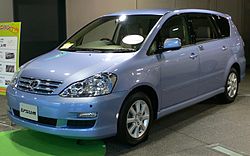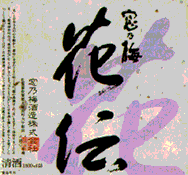JAPAN GETTING READY FOR WAR!
July 21, 2011
F.Y.I . Generations of Ipsum
First generation
 | |
| Also called | Toyota Picnic Toyota SportsVan |
|---|---|
| Production | 1995–2001 |
| Wheelbase | 2,735 mm (107.7 in) |
| Length | 4,530 mm (178.3 in) |
| Width | 1,695 mm (66.7 in) |
| Height | 1,620 mm (63.8 in) |
| Related | Toyota Gaia |
[edit] Second generation
 | |
| Also called | Toyota Avensis Verso Toyota Picnic Toyota SportsVan |
|---|---|
| Production | 2001–2009 |
| Wheelbase | 2,825 mm (111.2 in) |
| Length | 4,650 mm (183.1 in) |
| Width | 1,760 mm (69.3 in) |
| Height | 1,675 mm (65.9 in) |
FOR INQUIRIES: VISIT http://www.prosperjp.com/
And Look For:
Mr. Shin
Sales Department Representative
PROSPER CO., LTD Japan
shin@mercy.co.jp
+81-50-5539-9816
Add Me on Facebook.
Sales Department Representative
PROSPER CO., LTD Japan
shin@mercy.co.jp
+81-50-5539-9816
Add Me on Facebook.
JAPANESE ALCOHOL
  Alcohol appears in the earliest historical records. 3rd-century Chinese records describe the inhabitants of Japan as being fond of their liquor and this remains little changed today. Consumption of sake was overtaken by that of beer around the beginning of the 20th century. In recent years, beer and its cheaper relations happoshu and so-called "third-category beer" account for over 75% of alcohol consumption. Overall, per capita alcohol consumption has been in decline from a peak of 80 liters - that's more than 21 gallons - a year in 1999 and was around 74 liters in 2006. A generation of young Japanese had grown up in difficult economic times and were inclined to go for cheaper drinks or avoid alcohol altogether. But there are still a huge variety of different places to go out for a drink. Most are also places to eat as the western idea of the stand-up pub is relatively new to Japan.  When is a Beer Not a Beer?Japanese major beer brands - the top two are Asahi and Kirin, followed by Suntoryand Sapporo with a quarter of the market between them - are known worldwide. The biggest breweries produce a range of top-selling beers, such as No.1 seller Asahi'sSuper Dry, Sapporo's Black Label and Ebisu, Kirin's Lager and Ichiban Shibori and Suntory's Malts. In addition, they sell dozens of 'seasonal' brands for a few months at a time. These are generally lagers and easily outsell other brands such as stout (black beer). Appealing to the increased health consciousness of the Japanese consumer, terms like "zero calorie" and "low alcohol" have become marketing buzzwords. Happoshu (low-malt beer), has become more popular recently due mainly to the fact that it's significantly cheaper than regular beer. Happoshu typically retails for ¥30-40 less for a standard 350ml can because the low malt content puts it in a lower tax category. Sales of happoshu accounted for over a fifth of the beer market in recent years thanks also to heavy marketing. Taking a growing chunk of the market is "third-category beer." Made with malt substitutes like soybeans, corn and even peas, it has a taste close to that of regualr beer but at an even cheaper price thsan happoshu. Economic worries have led more Japanese consumers to consider price more carefully, and as the new alternatives are considerably cheaper, they have seen their share of the beer market grow to almost 30% in 2009. Korean-made third-category beers such as Muginosuke or Prime Draft can be had can be had for less than ¥100 a can. Meanwhile regular beer fell below the 50% market share level for the first time ever. The bigger breweries also produce other alcoholic beverages such as whisky, wineand shochu as well as soft drinks. |
World’s Most Expensive Sushi
World’s Most Expensive Sushi, using Diamonds, Pearls and Edible Gold Leaves

Usually the most expensive Sushi topping one can eat at a standard sushi restaurant in Japan should be Toro, belly meat of a tuna fish. Sometimes it costs $30 a piece in high-end sushi restaurant.
But this gorgeous sushi rolled with edible gold leaves is far more expensive. The sushi shown in the image above costs more than $4,000, which means $1,000 a piece, 10 times more pricey than Toro toppings.
Read on for list of deluxe ingredients.
But this gorgeous sushi rolled with edible gold leaves is far more expensive. The sushi shown in the image above costs more than $4,000, which means $1,000 a piece, 10 times more pricey than Toro toppings.
Read on for list of deluxe ingredients.
www.prosperjp.com
MIKI
miki@prosperjp.com
THE PAGODA
The pagoda has been one of the most recognizable forms of Japanese architecture throughout history. These unique temples have stood the test of time and are often used as tourist attractions today.
A Japanese pagoda is a square tower that is usually part of a monastery used by Buddhist monks. It served as a temple and housed sacred relics. Each of its levels, ascending, is slightly smaller than the last, resulting in a pyramid-like structure that is topped by a spire.
Construction
Japanese pagodas are typically constructed from wood with interlocking beams and posts and a central column. The buildings are tall and slender and consist of five stories. The roofs boast wide overhangs, with clay tiles. Pagodas are extremely sturdy and are designed to absorb the movements of the earth, making them resistant to earthquakes and typhoons.
History
The pagoda was introduced to Japan from China, and was influenced by the Indian stupa. The Horyu-ji pagoda, near Nara, dates back to the late seventh century.
Symbolisim
The square shape symbolizes the earth. The center column is considered the "axle of the world" and the spire on top of the structure represents Buddha as master of the universe. Each level represents one of the five elements: wind, water, earth, fire and sky.
Visitors to Kyoto and Nara, Japan's ancient capitals, invariably retain in their memories the evocative silhouette of a wooden pagoda--at times towering gracefully above the tiled rooftops of an old neighborhood, at times rising abruptly from the midst of a huddle of modern buildings. Most people familiar with the Kansai region will know the stately five-story pagoda of Kyoto's Toji (Kyoo Gokokuji) temple, clearly visible from the Shinkansen bullet train, or the pagoda of Nara's Kofukuji, standing at the edge of Sarusawa Pond.
FROM GREAT MINDS OF JAPANESE ARCHITECTURE
TO
TO
GREAT MINDS OF JAPANESE MECHANICAL ENGENEERING AND TECHNOLOGY
PROSPER CO., LTD
IS AN EXISTING PROOF OF GREAT SERVICE and QUALITY.
CHECK THIS OUT!!!
KEEP LIKING US ON FACEBOOK
for more details CONTACT US:
Ms. Mika Aoyuki
+81 505539 9816 || mika@prosperjp.com
Japanese Apples
Traditional Japanese apple farmers use stencils to emboss designs on fruit skin. (Photo: Jane Alden Stevens, University of Cincinnati Magazine)
The abundance, quality and diversity of the Western New York apple crops seem even more of an eater's windfall when you consider the apple's status in Japan.
In Japan, the fruit is usually reserved for special occasions, since a single apple can cost $10, according to this fascinating story by Deborah Rieselman in the University of Cincinnati Magazine.
Jane Alden Stevens, a UC photography professor, documented the practices of old-fashioned Japanese apple farmers, whose painstaking craftsmanship results in apples that sell for as much as $150. The younger farmers do things differently, and the practices are dying out.
These Japanese apple farmers pick most of an apple tree's blossoms to focus the plant's efforts on fewer fruit. Each apple is enclosed in a protective bag for most of its growth. Some take elaborate measures to focus sunlight on the fruit, such as laying reflective sheets underneath trees to bounce sunlight onto the apples' pale bellies.
For maximum effect, read it while crunching into a juicy Cortland.
Prosper Co. Ltd Japan
Offers variety of cars like apples:
Please contact me for your desired car:
Ms. Ai Tamaki
Sales Representative
Office Tel #: +81-50-5539-9816
SUPER LONG DX
2006 TOYOTA / HIACE VAN
FOB $21,586 ONLY
Stereo
AirConditioner,
Not only VERY LONG, but also VERY NICE CONDITION
so be the first one to inquire for this
Just contact the in charge
HIRO
+81-5055-32-8180
of
Prosper Co.,Ltd
Your Blood Type Says It All
In Japan, Each blood type has a personality profile.
Type APeople with blood type A have a deep-rooted strength that helps them stay calm in a crisis when everyone else is panicking. However, they tend to avoid confrontation, and feel very uncomfortable around people. A types are shy and sometimes withdrawn. They seek harmony and are very polite, but all the same feel that they never really fit in with others. A types are very responsible. If there is a job to be done, they prefer to take care of it themselves. These people crave success and are perfectionists. They are also very creative, and the most artistic of all the blood types, most likely because of their sensitivity.
People with blood type A are also likely to be considered classic "type A's": stressed and conscientious. In anime, people like Hotohori are type A's.
Type BPeople with blood type B are the most practical of the blood groups. They are specialists in what they do. When they start a project, they spend extra time understanding and trying to follow directions than others might. When they are doing something, all of their attention is focused on it. They tend to stick to a goal and follow it through to the end, even if it seems impossible. They tend to be less than cooperative, as they like to follow their own rules and their own ideas. They are individualists. B type people pay attention to their thoughts a little more than their feelings, and therefore can sometimes seem cold and serious.
People with blood type B are often considered more relaxed, freewheeling, and unconventional than other types, although not necessarily to an unacceptable degree. In anime, the genki, off-the-wall types are type B, along with any kind of well-intended character who's ruled by their impulses.
Type OPeople with blood type O people are outgoing, energetic and social. They are the most flexible of the blood types. They easily start up projects but often have trouble following through because they give up easily. They are flighty and not too dependable. O types always say what's on their mind. They value the opinion of others and like to be the center of attention. Also, people with O blood are extremely self-confident.
Type O, the most "average" blood type, is considered the best type in Japan.
Type ABPeople with blood type AB are hard to categorize. They can have characteristics on both ends of the spectrum at the same time. For instance, they are both shy and outgoing. They easily switch from one opposite to another. AB people are trustworthy and responsible, but can't handle it when too much is asked of them. They don't mind doing favors or helping out, as long as its on their own conditions. People with this blood type are interested in art and metaphysics.
AB is considered the worst blood type. In predictability-loving Japan, they're loose cannons. They also like to set their own conditions and reserve the right to drop out when things don't meet their expectations. They're known to be sensitive and considerate—at times—but it just isn't enough to balance out the flaws in this blood type. For a while, some companies tried dividing their employees into work groups based on blood type, and no one wanted to work with the AB group. Anime villains are likely to be type AB.
Now do you know? what type of personality you have?
Thank you very much.
AYA
aya@mercy.co.jp
Subscribe to:
Comments (Atom)

































